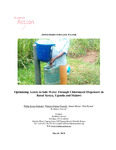| dc.description.abstract | The use of unsafe water has been the primary cause of diarrhea, the main child- Mortality contributor causing 1 in every 10-child deaths (WHO, 2009), yet 58% of diarrhea cases can be averted through safedrinking water, sanitation and hygiene (WHO, 2014). Use of chlorine treatment reduces diarrhea risk by 40% for regular users. Evidence Action is implementing a community-based “Dispensers for Safe Water (DSW)” program aiming at improving community access to safe drinking water by installing chlorine dispensers at communal water points in rural areas. The installed free chlorine dispensers currently provide 4.7 million people across Kenya, Uganda, and Malawi with access to quality household safe drinking water. This study utilized a cross-sectional design with multi-stage stratified sampling techniques to assess chlorine adoption among communities in Kenya, Uganda, and Malawi. The sample consisted of 73,513 households and 8,319 water points across three countries. Two-stage sampling technique was used to select water points and households to be visited; stratified sampling method where Uganda, Malawi, and Kenya were treated as strata and used a simple random sampling method to select 1.5% water points within each stratum. The simple random sampling method was used to select eight households per water point that were visited every two months to assess; dispenser hardware functionality, community Chlorine adoption rates and availability of chlorine. Results indicated that; female respondents from Uganda and Malawi were respectively 4.3% and 3.7% more likely to chlorinate their water. Educated households were 18% more likely to use chlorinated water than the uneducated. Households with children under 5 years were more likely to chlorinate their water in Kenya and Uganda, unlike in Malawi (p=0.001). Furthermore, community knowledge about the chlorine dispensers and other water treatments methods contributed significantly (p<0.001) to a household using chlorine across the three countries. In Kenya, households that attended Village Community Sensitization forums were 3.2% more likely to treat their water, while in Uganda and Malawi, households who attended Community Education Meetings were 2.5% and 7.0% respectively more likely to chlorinate their water, unlike in Kenya. Community members who heard from promoters (within 30 days) were 32% in Kenya and 89% in Malawi more likely to chlorinate their water. Rural community adoption of chlorine safe water treatment is associated with gender, education level, community dispenser knowledge, social clubs attendance and access to promoters. Future programs need to prioritize increasing Community’s knowledge and skills of chlorine water treatment mechanism through strengthening community Promoter model, extending water treatment education to children ensuring adequate Chlorine supply chain and leveraging on call centers/ text message as communication channels. | en_US |

